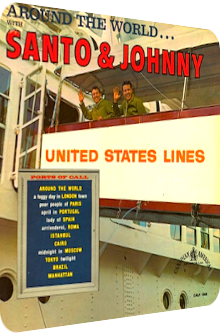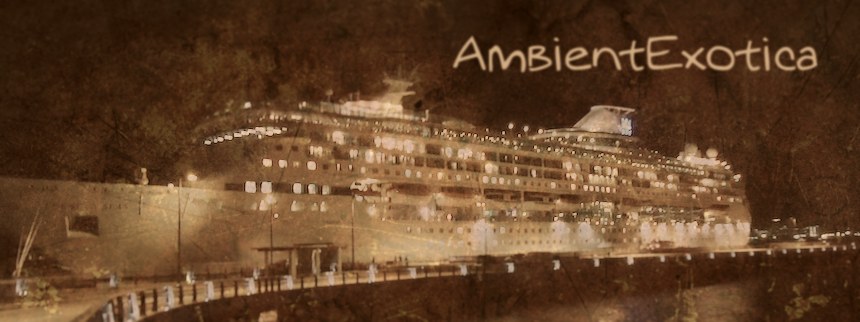
Santo & Johnny
Around The World
1962
If I tell someone – anyone! – about the delight that the music of the New York-based brothers Santo & Johnny Farina (born 1937 and 1941) is able to spread, people rightfully gaze at me in the most skeptical way for three reasons: firstly, the brothers, whose career lasted from the late 50's until the mid-70's, were always well-dressed, had good looks and behaved in the best possible manner. It's admittedly strange for outsiders when new generations discover such music. Secondly, people think that Santo & Johnny are about glitzy Pop, but both aren't singers rather than talented composers and guitarists who feel right at home with either the steel guitars or their electric brethren in their hands. And finally, their music can be partially linked to the Exotica genre, but many people beg to differ as well, and rightfully so, I have to admit. A steel guitar alone doesn't make a Hawaiian song, and their larger arrangements which comprise of Hollywood strings, exotic percussion and scattered brass sections don't make Santo & Johnny an Exotica duo in the classic sense. Fair enough, I cannot argue about this.
I can, however, link one specific album by them – Around The World With Santo & Johnny of 1962 – to two overarching themes that are found in lots of Exotica records, namely the yearning for far away places and the so-called travelog motif where conductors or bands present the usual amount of 12 pieces that each depict a different location or country. Among such travelog albums are John Scott Trotter's Escape To The Magic Of The Mediterranean (1956), Axel Stordahl's Lure Of The Blue Mediterranean (1959), Norrie Paramor's Jet Flight (1959), Warren Barker's A Musical Touch Of Far Away Places (1959), Irv Cottler's Around The World In Percussion, Bert Kaempfert's The Magic Music Of Far Away Places (1965) – gasp! – and many others too numerous to mention, but scheduled for further reviews sometime in the future. All these artists, conductors and arrangers either create aural journeys with the help of bigger orchestras or more intimate boat trips with smaller band settings. And this is what Santo & Johnny do as well. And it's a rather grand release complete with horns, a female choir and lots of mallet instruments. Exotica or not, Around The World With Santo & Johnny is exotic enough to consider it in this section, so without further quibbles, here we go.
Fittingly enough, the album starts with a rendition of Victor Young and Harold Adamson's Around The World, the one and only song title on this album that doesn't refer to a specific location. Launching with huge boosts of contentment thanks to wafting strings, twinkling vibraphone drops and ba-da-dah wisdoms sung by a female choir, the brothers' guitars are of less importance. The original lyrics are still intact, though. Otherwise, this song underwhelms, as the mellifluous violin strings don't work well at all with the surf attitude and the spiraling double bass backing. A Foggy Day (In London Town) by the Gershwin brothers is way better and exotic on its own, as many counterintuitive ingredients are concocted, for example clicking castanets (very British?!), a repeated wonky five-note motif on the steel guitars that's more Honolulu-evoking than London-based, and brass eruptions that finally seem to fit in the given context. It's a swinging track, and all instruments of the Gershwin original seem to be reassembled or mixed up, making this a positively weird track.
While the iconic Poor People Of Paris, adapted by Jack Lawrence in 1954, is foaming over of kitsch thanks to romantic strings of all kinds and octaves that form a rose-tinted background for Johnny's and Santo's guitar main melody, Raul Ferrão's April In Portugal merges droning brass accents with downbeat steel guitar breezes. It is here where the guitars really shine, but are almost beaten by the vivifying nature of the horns. Next is Robert Hargreaves' and Tolchard Evan's Lady In Spain of 1931, a toreroristic fanfare of the finest order, with sun-gleaming brass eruptions, mellow castanet waves, convivial brass melodies and polyphonous xylophone accents. Johnny's guitar is of particular interest here, for it is neither a steel guitar, nor an acoustic guitar. It's some string instrument that's distantly similar to a shamisen, but not that Far Eastern. It's no banjo either, for the attack is too punchy. Whatever this instrument really is, it enhances the whole exotic level of the track.
The final track of side A, Arrivederci Roma by Renato Rascel, injects a huge dose of stereotypical sugar into the ears, as the female choir melts away in melodramatic streams when the jaw harp is played, maracas are shaken and pizzicato strings are in a constant dialogue with their soothing brethren. The most successful ingredient, however, are the bongos that provide the necessary bit of exotic jungle atmosphere to cope with the saccharine glob of glee. I'm definitely no fan of this rendition and avoid it whenever I can.
Side B continues the journey in a much more superb way, as the next stop is in Nat Simon's and Jimmy Kennedy's Istanbul (Not Constantinople). This world-famous melody is wonderfully performed on frantic castanet-interspersed surf guitars complete with menacing brass accompaniments. Sizzling-hot Eastern tone sequences exchange with Hawaiian surf melodies, making this a highly successful take full of coolness, independence and traces of bile. The brothers move on to Cairo, which is actually their very own hit single Slave Girl in disguise. Absolutely delicate steel guitar twangs that encompass both warped Space-Age tonalities and faux-Polynesian dreaminess are placed in front of hollow drum kit percussion with a large sustain, creating a balmy mirage that is tremendously catchy and memorable. It's a superb hit, and although Cairo doesn't add anything substantially new to the Slave Girl formula, its inclusion is a huge success. Only very recently did I discover that both songs are the same, for I hadn't listened to Around The World in a long time.
While the journey continues to Kenny Ball's and Vasili Soloviev-Savoy's Midnight In Moscow which surprises with pumping beats in a Dixieland-flavored New Orleans style that's heavy on the screeching horns and melancholic steel guitar licks, the Farina brothers' own Tokyo Twilight literally has the word success written all over it, as mystical wind chimes, ghostly Far Eastern violin strings and golden-shimmering accordion stabs are intertwined with wafting alto flutes, sunset-red steel guitar threads and hollow bamboo rods. What a hugely laid-back tune.
A decisive change of pace is due: Ary Barroso's Brazil is the most upbeat song with exhilarative flutes, magnanimous brass sections, lavish strings and – naturally – another golden thread of steel guitars. It cannot get much sunnier than this, and the mood is exuberant and lively. It's no standout rendition per se, but expands the endemic mood of the album nonetheless. The final piece sees Santo & Johnny back in their home town. Manhattan by Richard Rodgers and Lorenz Hart, originally written in 1925 already, is the dreamy end of a journey with a breathtaking steel guitar-related euphony, joyfully pulsating strings, cozy alto flute accents and mild-mannered brass bursts. While the guitars remain in the spotlight, it is in fact the strings that make the difference, as they were never featured in such a glaring way on the album heretofore. A streamlined, Easy Listening-focused end, and a great track overall.
"Gimme side B, that's all I need!" is my personal credo in terms of Around The World With Santo & Johnny in a nutshell. The surf attitude that's married with strings and horns is successful most of the times, and while I don't agree with every choice the brothers come up with – Around The World is too bland and Arrivederci Roma an affront to the ears –, there are many hits to be found on the album that make me forget the missteps of the duo. Especially side B glimmers and sparkles. It is an astonishing testimony that Santo and Johnny's own creations outclass the remaining material in an almost embarrassing clarity. The camouflaged Slave Girl is titled Cairo on here, a trick similar to Bert Kaempfert's mega hit Spanish Eyes which he reintroduced as Moon Of Naples in his aforementioned travelog LP The Magic Music Of Far Away Places, and the Far Eastern Tokyo Twilight plays in a class of its own as well, as it features the largest pool of instruments and yet doesn't feel overly crowded at all.
The travelog of Santo & Johnny isn't the most coherent Exotica album, and some choices are actually questionable, the castanets in the London tune for instance, but lovers of steel guitars might risk a look at this colorful artifact of the 60's, as it is easily available on iTunes, Amazon and their competitors. Cherry picks include Cairo, Tokyo Twilight, Manhattan and possibly Poor People Of Paris as well as Istanbul (Not Constantinople). Fans of Dark Exotica, though, should beware, as the bedazzling kitsch is definitely not made for them. But all in all, the Bros. Farina deliver a noteworthy album whose parts are better than its sum in the end.
Exotica Review 133: Santo & Johnny – Around The World With Santo & Johnny (1962). Originally published on Oct. 13, 2012 at AmbientExotica.com.
